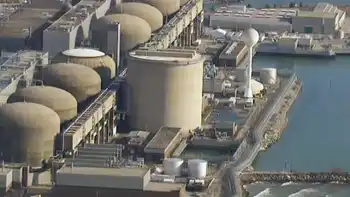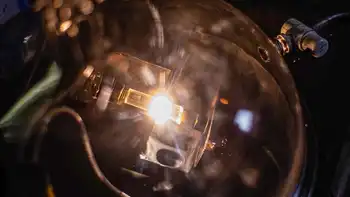The little island and its big, green victory
By The Independent
NFPA 70e Training
Our customized live online or in‑person group training can be delivered to your staff at your location.

- Live Online
- 6 hours Instructor-led
- Group Training Available
But in a sodden field, three so-called "harmonious" wind turbines were working flat out and pouring cash into the islanders' bank accounts.
The huge blades of the 70-ft wind turbines sliced through the rain like giant revolving scythes, their whooshing sound audible as you stood beneath, even through the howling gale. That the island of Samso is an ideal place to harness the power of the wind seemed blindingly obvious in the midst of this wild storm.
The inhabitants of this Danish isle seized upon wind's potential as a source of energy and money more than a decade ago. Since then the Baltic island has become one of the first industrialized places on the planet to qualify as being totally energy self-sufficient.
It is a major propaganda victory for a country that will shortly be hosting the world summit on climate change – in fact, Copenhagen delegates will be flown or ferried out here next month to see Samso for themselves. The island's inhabitants are proud of what they have achieved. "Being part of a project like this gives you a wonderful feeling of being in harmony with nature," resident Erik Andersen explained.
The 64-year-old cattle farmer has shares in a wind turbine, solar panels on his roof and runs his tractor on home-grown rape-seed oil. He feeds the mush that's left over to his cows. When all of his alternative energy sources are working, he delights in looking at the electricity meter that offsets his own power against what he has to import. "On a good day the meter runs backwards," he said.
One could be forgiven for thinking that Samso's inhabitants are all dyed-in-the-wool muesli-munching Green Party voters, willing to make big personal sacrifices to further the environmental cause. Yet most of the islanders are ordinary Danish farmers, who started out with a skeptical attitude to green power.
It took one of their own kind to convince them otherwise. Soren Hermansen, a one-time vegetable farmer is the man behind the island's energy revolution. Nowadays he flits between places as diverse as the United States, the Scilly Isles and Tasmania in his new role as global green-energy guru. The lavatory walls at Samso's Energy Academy, where Mr Hermansen has his office, are covered with cartoons portraying him as a green superman. One has him mouthing the slogan: "Wife, make me a cape".
But back in 1997, Mr Hermansen was a frustrated small farmer trying to earn a few kroner in a market that was becoming dominated by large farming concerns. Samso was in crisis at the time because one of the island's main businesses – a slaughterhouse employing 100 workers – had been forced to close down. "With hindsight, it was the ideal time to start a new project," Mr. Hermansen, 50, recalled. "A crisis makes people much more open to new ideas."
That year, the energy ministry, run by Denmark's then green-minded socialist government, announced a competition to find out how much renewable energy could be produced in a single district. The aim was to create an area that was energy self-sufficient. Boroughs and municipalities were invited to put forward proposals and compete against each other.
An engineer called Ole Johnsson from the mainland town of Aarhus became fascinated by the competition. He saw Samso as the ideal place to realize the energy self-sufficiency dream. After studying the island's annual wind-speed and sunshine-hour records, he calculated how much energy the island could produce from wind turbines and other alternative sources and concluded it was possible to beat conventional sources. He sent the plan to Copenhagen and it won.
Mr Johnsson persuaded the Samso islanders to form an energy association to start implementing the plan. Fifty people came to the first meeting, including Mr. Hermansen who saw the potential and grabbed it. Within days, he was out and about on the island, canvassing for people's support. "I'd do things like rent a fruit press and announce plans to press apples in a particular village," he said. "We'd get all the fruit done and then start talking about the project and I had to convince them that it was our future."
But there were three elements without which the project would probably never have got off the ground. Firstly, Danish laws oblige the country's energy suppliers to buy wind energy at prices that are higher than it costs to produce. Secondly, back in the late 1990s, Samso just happened to be in the parliamentary constituency of Svend Auken, Denmark's late and hugely popular green-minded Social Democrat energy minister, who made sure that the island got the project.
Thirdly, his government pledged to underwrite bank loans to any Samso resident who opted to take a share in a wind turbine. "Effectively the banks were giving the islanders loans that were completely watertight," Mr. Hermansen said. "They knew they couldn't lose."
With half the battle already won by the state, Mr. Hermansen then had to persuade people to switch from traditional energy sources. "It only worked because we got people to swap the usual 'NIMBY' (not in my back yard) attitude to wind turbines for an 'IMBY' attitude," Mr. Sorensen said. "People began to realize that they were doing something unique in the very place where they live. It was not something that was imposed from above. It belongs to them."
The island's farmers began to realize that they could make money from the straw that was left over after the harvest because it could be baled up and burned in the island's straw-fired heating plant. Likewise foresters, working in the island's woodlands, began using dead trees to manufacture woodchips for furnaces. "We have just managed to reach our goal of self-sufficiency," said Mr. Hermansen. "But it would have been difficult to achieve without generous government funding."
A decade ago, Samso relied heavily on oil imports for heat and power, but now – thanks to its windmills and alternative energy plants – it manages to produce more green-generated power than the amount of "dirty" energy it still has to bring in to run its cars and some of its homes. Three-quarters of the island's heating needs are currently met by alternative energy sources such as wind.
The island – 30 miles long and 15 wide – is reputed to be one of the most successful green-energy projects to have got off the ground since environmentalists started raising the alarm about climate change three decades ago.
Samso has 21 wind turbines – 10 on a sandbank off the island's south coast, half of which are owned by the local council. The other 11 are dotted all over the island and owned by more than 450 residents-cum-shareholders. To make their presence as inoffensive to the eye as possible, the turbines are of the "harmonious" – as opposed to the more offensive "gorilla" – type, which means they are all painted the same colour and have a standard height and blade length.
But wind turbines are just the most visible part of the energy revolution. Samso heats the homes of its 22 villages with power plants that rely on furnaces fired by woodchips and straw. Banks of man-sized solar panels lie in fields, kept trim by herds of bleating sheep. One farmer has even developed a special pump to use the warmth supplied by cow's milk to heat his home.
Another effect of the green-energy boom is that the island's plumbers and carpenters have now all become experts in energy-saving home conversion and insulation techniques. Most of Samso's houses are carefully insulated and equipped with double-glazed windows to minimize heat loss. One of them belongs to Uffe and Else Marie Bach. Their painstakingly restored 150-year-old former school house in the Samso village of Torup is heated by a so-called Maas oven, a white-washed brick construction on the ground floor, which Mr. Bach, a retired plumber, fires up for two hours every morning with logs he cuts from the woods with a chainsaw.
The heat generated is so intense that the bricks surrounding the oven stay warm for 24 hours and help to heat most of the house. Hot water is supplied by a pump, powered by electricity from the wind turbine, which sucks in the earth's natural warmth collected from 1,300ft of pipe buried underground in a field next to the house.
A decade ago, the Bachs bought €25,000 worth of shares in one of the island's wind turbines. The upshot has been dramatically reduced electricity bills and a €3,000 dividend payment last year – the profit resulting from the sale of their turbine's electricity. "Finally, we are beginning to make a bit of money," said Mr Bach.
Despite its egalitarian principles, it is the big financial investors in Samso's energy revolution who have come out on top. One of them is Jörgen Tranberg, who owns a 250-acre dairy farm. With help from the bank, the 55-year-old farmer invested €2.5m in wind turbines. He paid €1.2m for the one on his farm he owns outright and he is half-owner of one of the offshore turbines, too. He claims that on a good day the windmills alone can earn him €3,000.
With figures like that, it's not surprising that the project has aroused interest from far beyond Denmark's borders. Mr. Hermansen likes to recount the story of the Egyptian ambassador's visit. After taking a tour of the island and examining all its green-energy projects in great detail, his excellency asked how many people lived on Samso. About 4,000 he was told. "That's three city blocks in Cairo!" he exclaimed. "Maybe that's where you should start," came Mr. Hermansen's sanguine reply. "Not with the whole of Egypt but by taking one block at a time."











